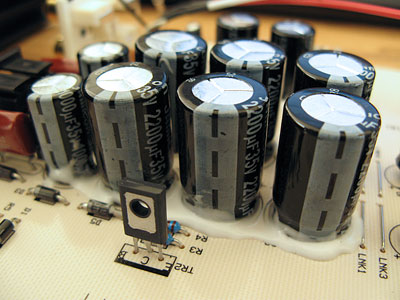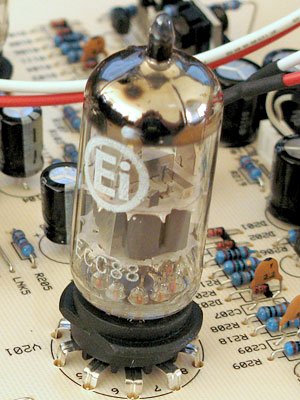|
|
Post by bonesinc on Mar 8, 2007 12:35:45 GMT
I just opened my X-Can V3 because I wanted to put in my 'new' valves. Maybe I didn't look closely enough at all the previously posted pictures of the interior of the V3 but what I saw surprised me a bit. And it wasn't an entirely positive surprise. It looks like Musical Fidelity doesn't want us guys to mod our X-Cans anymore, at least not most of the caps. This is what I looked at:  Glue on the caps! And pretty tough glue it is. Although it might look like a rubbery substance, it definately isn't. After touching the glue I'm under the impression that it's not easily removed at all. Another point which surprised me (don't know if it's positive of negative) is the type of stock valves. I don't know what the stock JAN's look like exactly but I don't think these are the ones:  So, am I completely off track and does my X-Can look like everybody else's or has Musical Fidelity decided to not let customers tinker with the caps in this amp and decided to put in different valves along the way? Please, enlighten me. Cheers! |
|
|
|
Post by PinkFloyd on Mar 8, 2007 15:53:12 GMT
I just opened my X-Can V3 because I wanted to put in my 'new' valves. Maybe I didn't look closely enough at all the previously posted pictures of the interior of the V3 but what I saw surprised me a bit. And it wasn't an entirely positive surprise. It looks like Musical Fidelity doesn't want us guys to mod our X-Cans anymore, at least not most of the caps. This is what I looked at:  Glue on the caps! And pretty tough glue it is. Although it might look like a rubbery substance, it definately isn't. After touching the glue I'm under the impression that it's not easily removed at all. They've always used glue under the 2200uF caps but not usually that much. All you have to do is desolder the cap pins on the underside of the board (with either a pump or braid) and then literally snap the caps off the board, they actually come off quite easily. No need to remove the glue from the board just position the new caps on top of it..... you can remove the glue if you want by levering it with a very thin blade screwdriver.... I personally wouldn't touch it and just fit the new caps on top of it. First time I've seen an ECC88 as stock, they are normally 6922 (E88CC) the difference?..... ECC88= 6DJ8 E88CC= 6922 (longer life, higher current capability) Maybe MF have finally depleted their stock of 6922..... who knows ;D How old is the amp by the way? So, am I completely off track and does my X-Can look like everybody else's or has Musical Fidelity decided to not let customers tinker with the caps in this amp and decided to put in different valves along the way? Please, enlighten me. Cheers![/quote] |
|
|
|
Post by bonesinc on Mar 8, 2007 18:20:55 GMT
I received the amp about 2 weeks ago. The amp is a new one.
On the back it says it was built in November 2006.
|
|
|
|
Post by PinkFloyd on Mar 8, 2007 22:02:54 GMT
I received the amp about 2 weeks ago. The amp is a new one. On the back it says it was built in November 2006. Must be the way they're doing them now bones...... I can tell you the ECC88 valves you have on board are Yugo EI (Yugoslavian) types. What do the 6N1P-EB sound like compared to them? |
|
|
|
Post by bonesinc on Mar 8, 2007 22:55:22 GMT
I can tell you the ECC88 valves you have on board are Yugo EI (Yugoslavian) types. What do the 6N1P-EB sound like compared to them? I'll try to describe it, based on my time limited experience with the 6N1P-EB. Mind you, I'm not into the 'art' of reviewing! I listened to my X-Can V3 with my beyerdynamic DT-770 80 ohm and my DT-990 250 ohm. The 6N1P-EB sound more music like then the EI ECC88. The EI ECC88 sound a bit more 'congested' and dull. I like the highs of the 6N1P-EB more and the bass seems to roll of less then with the EI ECC88. Highs seem to have a bit more separation with the 6N1P-EB. I've seen people describe the change in sound like 'there is more air around instruments'. I don't know if that's a good way to describe sound but if it is, the 6N1P-EB do a better job then the EI ECC88. Music sounds a bit more layered, in a pleasant way. While the EI ECC88 give quite a bit of dimension to the music the 6N1P-EB gives me more. With dimension I mean the 'out of your head experience' in virtually every direction. This increased dimension may be the reason that I experience a bit more 'air' around instruments and because of that I'm under the impression that I'm able to hear more of the instrument. Like the touch of fingers on the strings of acoustic guitars. It might have been present with the EI ECC88 but if it was, it was harder to hear. I don't experience anything like the sound is 'warmer' or 'colder' with the one or the other. Conclusion: for me, music is more enjoyable with the 6N1P-EB then it is with the EI ECC88. And that's what counts for me. Someone else may actually like the EI ECC88 more. I guess it depends on your taste of music and used headphones. Let's put it this way: Changing the valves from EI ECC88 to 6N1P-EB changed my X-Can V3 from listening to music to experiencing music. If it sounds good I see no reason to change valves but with the stock ones I did have the feeling to change valves from the beginning. Right now I'm listening to Jack Johnson's - 3 R's and I like the bass guitar and bass drum a lot!!! This is more what I was looking for to hear. |
|